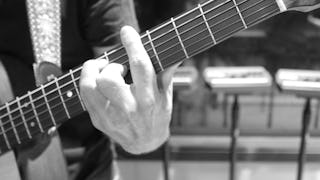Many beginning guitarists have learned the basics of open and movable chord shapes, but want to further expand this chord knowledge. In this course you’ll learn how to construct and play triads and basic 7th chords. You’ll start by creating major and minor triad inversions, and move on to power chords, drop-2 voicings, and learn how to substitute common chords to create a richer harmonic experience for listeners. Throughout the course, you will focus on the notes that chords are made up of, rather than the shape of individual chords. With this knowledge, you will be able to create inversions and different chord voicings up and down, and across the entire fretboard of the guitar, thus unlocking new ways of playing the guitar.

Enjoy unlimited growth with a year of Coursera Plus for $199 (regularly $399). Save now.

Guitar Chord Voicings: Playing Up The Neck
This course is part of How to Play Guitar Specialization

Instructor: Rick Peckham
14,303 already enrolled
Included with
(55 reviews)
Recommended experience
What you'll learn
Look at a lead sheet and play chord voicings
Construct triads, 7th chords, and inversions
Play and know the voicings of various chord qualities such as a major triad, minor triad, dominant 7, and gospel chords
Play triads over bass notes
Skills you'll gain
Details to know

Add to your LinkedIn profile
See how employees at top companies are mastering in-demand skills

Build your subject-matter expertise
- Learn new concepts from industry experts
- Gain a foundational understanding of a subject or tool
- Develop job-relevant skills with hands-on projects
- Earn a shareable career certificate

There are 4 modules in this course
Welcome to Guitar Chord Voicings: Playing Up the Neck! Here we will cover all the details about the course and what you'll need to know to get the most out of your experience. Then, we'll learn how to rearrange the notes in a triad to create inversions. Inversions can be difficult to conceptualize on the guitar since the same pitch can be found on different frets and different strings. We'll work to make this concept as easy as possible by inverting triads from the high strings to low and from the lower range of the neck up to the higher frets. The more you know about chords on the guitar, the larger the number of options for you to use!
What's included
6 videos8 readings2 assignments1 peer review1 discussion prompt
Power chords and barre chords represent a huge amount of the vocabulary used by guitarists in rock and pop music. Although they may be a bit tough on your fretting fingers at first, the many applications of these shapes make the effort worthwhile. In this module, we'll cover various exercises that will give you greater facility and command of these chords.
What's included
3 videos3 readings2 assignments1 peer review
There are several ways to learn new voicing shapes on the guitar. Drop-2 is a term used at Berklee to describe a configuration of chord tones, pleasing to the ear, and, more importantly to guitarists, relatively easy to execute on the fretboard. It's the best way to play seventh chords on four consecutive strings. This module is going to give you plenty of practice in creating new voicing shapes on the fretboard and will help you develop the ability to play various seventh chords in all keys.
What's included
3 videos3 readings2 assignments1 peer review
We've learned many guitar voicings for triads and seventh chords. This module will help you to solidify your grasp of Drop-2 Seventh chords. We'll also explore some new ways of using what we've already learned. Finally, we'll look at how to substitute chords using a standard lead sheet.
What's included
4 videos5 readings2 assignments1 peer review
Earn a career certificate
Add this credential to your LinkedIn profile, resume, or CV. Share it on social media and in your performance review.
Instructor

Offered by
Explore more from Music and Art
 Status: Free Trial
Status: Free Trial Status: Free Trial
Status: Free TrialBerklee
 Status: Free Trial
Status: Free TrialBerklee
 Status: Free Trial
Status: Free Trial
Why people choose Coursera for their career




Learner reviews
55 reviews
- 5 stars
83.63%
- 4 stars
10.90%
- 3 stars
1.81%
- 2 stars
1.81%
- 1 star
1.81%
Showing 3 of 55
Reviewed on May 17, 2023
An excellent introduction to chord structure and inversions. Thanks!
Reviewed on Jul 9, 2020
Excellent course. Good theoretical base and sensible practical application.
Reviewed on Nov 9, 2021
Great practice for learning some new chord shapes!
Frequently asked questions
To access the course materials, assignments and to earn a Certificate, you will need to purchase the Certificate experience when you enroll in a course. You can try a Free Trial instead, or apply for Financial Aid. The course may offer 'Full Course, No Certificate' instead. This option lets you see all course materials, submit required assessments, and get a final grade. This also means that you will not be able to purchase a Certificate experience.
When you enroll in the course, you get access to all of the courses in the Specialization, and you earn a certificate when you complete the work. Your electronic Certificate will be added to your Accomplishments page - from there, you can print your Certificate or add it to your LinkedIn profile.
Yes. In select learning programs, you can apply for financial aid or a scholarship if you can’t afford the enrollment fee. If fin aid or scholarship is available for your learning program selection, you’ll find a link to apply on the description page.
More questions
Financial aid available,
¹ Some assignments in this course are AI-graded. For these assignments, your data will be used in accordance with Coursera's Privacy Notice.





